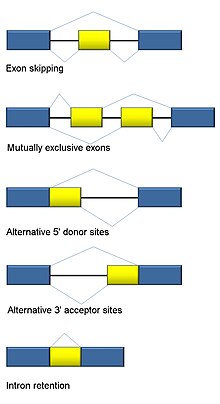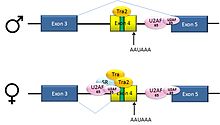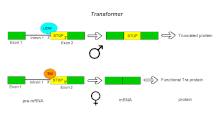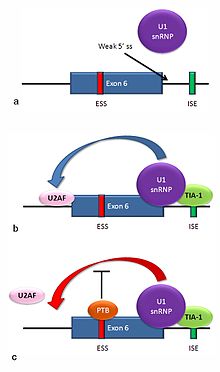| Somatic symptom disorder | |
|---|---|
| Other names | Somatoform disorder |
| Specialty | Psychiatry, Psychology |
| Symptoms | Maladaptive thoughts, feelings, and behaviors in response to chronic physical symptoms. |
| Complications | Reduced functioning, unemployment, financial stress, and interpersonal difficulties. |
| Usual onset | Often begins in childhood, however, onset is variable. |
| Duration | At least 6 months. |
| Causes | Heightened awareness of bodily sensations and the tendency to misinterpret bodily sensations. |
| Risk factors | Childhood neglect and abuse, chaotic lifestyle, history of substance and alcohol abuse, and psychosocial stressors. |
| Diagnostic method | Psychiatric assessment. |
| Differential diagnosis | Adjustment disorder, body dysmorphic disorder, obsessive-compulsive disorder, conversion disorder, and illness anxiety disorder. |
| Treatment | Cognitive-behavioral therapy, psychiatric medication, and brief psychodynamic interpersonal psychotherapy. |
| Medication | Selective serotonin reuptake inhibitor's and Serotonin–norepinephrine reuptake inhibitor's. |
| Prognosis | Often chronic but can be managed with the proper treatment. |
| Frequency | About 13-23% of the general population. |
Somatic symptom disorder, also known as somatoform disorder, is defined by one or more chronic physical symptoms that coincide with excessive and maladaptive thoughts, emotions, and behaviors connected to those symptoms. The symptoms are not purposefully produced or feigned, and they may or may not coexist with a known medical ailment.
Manifestations of somatic symptom disorder are variable; symptoms can be widespread, specific, and often fluctuate. Somatic symptom disorder corresponds to the way an individual views and reacts to symptoms as rather than the symptoms themselves. Somatic symptom disorder may develop in those who suffer from an existing chronic illness or medical condition.
Several studies have found a high rate of comorbidity with major depressive disorder, generalized anxiety disorder, and phobias. Somatic symptom disorder is frequently associated with functional pain syndromes like fibromyalgia and IBS. Somatic symptom disorder typically leads to poor functioning, interpersonal issues, unemployment or problems at work, and financial strain as a result of excessive health-care visits.
The cause of somatic symptom disorder is unknown; however, somatic symptoms may result from a heightened awareness of specific physical sensations paired with a tendency to interpret these experiences as signs of a medical ailment.
Signs and Symptoms
Somatic symptom disorder can be detected by an ambiguous and often inconsistent history of symptoms that are rarely relieved by medical treatments. Additional signs of Somatic Symptom Disorder include interpreting normal sensations for medical ailments, avoiding physical activity, being disproportionately sensitive to medication side effects, and seeking medical care from several physicians for the same concerns.
Manifestations of Somatic symptom disorder are highly variable. Recurrent ailments usually begin before the age of 30; most patients have many somatic symptoms, while others only experience one. The severity may fluctuate, but symptoms rarely go away completely for long periods of time. Symptoms might be specific, such as regional pain and localized sensations, or general, such as fatigue, muscle aches, and malaise.
Those suffering from Somatic symptom disorder experience recurring and obsessive feelings and thoughts concerning their well-being. Common examples include severe anxiety regarding potential ailments, misinterpreting normal sensations as indications of severe illness, believing that symptoms are dangerous and serious despite lacking medical basis, claiming that medical evaluations and treatment have been inadequate, fearing that engaging in physical activity will harm the body, and spending a disproportionate amount of time thinking about symptoms.
Somatic symptoms disorder pertains to how an individual interprets and responds to symptoms as opposed to the symptoms themselves. Somatic symptom disorder can occur even in those who have an underlying chronic illness or medical condition. When a somatic symptom disorder coexists with another medical ailment, individuals overreact to the ailment's adverse effects. They may be unresponsive toward treatment or unusually sensitive to drug side effects. Those with somatic symptom disorder who also have another physical ailment may experience significant impairment that isn't expected from the condition.
Comorbidities
Most research that looked at additional mental illnesses or self-reported psychopathological symptoms among those with Somatic Symptom Disorder identified significant rates of comorbidity with depression and anxiety, but other psychiatric comorbidities were not usually looked at. Major depression, generalized anxiety disorder, and phobias were the most common concurrent conditions.
In studies evaluating different physical ailments, 41.5% of individuals with semantic dementia, 11.2% of subjects with Alzheimer's disease, 25% of female patients suffering from non-HIV lipodystrophy, and 18.5% of patients with congestive heart failure fulfilled Somatic symptom disorder criteria. 25.6% of individuals with fibromyalgia fulfilled Somatic symptom disorder criteria, and they exhibited higher depression rates than those with fibromyalgia who didn't meet the criteria for Somatic symptom disorder. In one study, 28.8% of those with Somatic Symptom Disorder had asthma, 23.1% had a heart condition, and 13.5% had gout, rheumatoid arthritis, or osteoarthritis.
Complications
Alcohol and drug abuse are frequently observed, and sometimes used to alleviate symptoms, increasing the risk of dependence on controlled substances. Other complications include poor functioning, problems with relationships, unemployment or difficulties at work, and financial stress due to excess health care visits.
Causes
Somatic symptoms can stem from a heightened awareness of sensations in the body, alongside the tendency to interpret those sensations as ailments. Studies suggest that risk factors of somatic symptoms include childhood neglect, sexual abuse, a chaotic lifestyle, and a history of substance and alcohol abuse. Psychosocial stressors, such as unemployment and reduced job performance, may also be risk factors. There could also be a genetic element. A study of monozygotic and dizygotic twins found that genetic components contributed 7% to 21% of somatic symptoms, with the remainder related to environmental factors. In another study, various single nucleotide polymorphisms were linked to somatic symptoms.
Psychological
Evidence suggests that along with more broad factors such as early childhood trauma or insecure attachment, negative psychological factors including catastrophizing, negative affectivity, rumination, avoidance, health anxiety, or a poor physical self-concept have a significant impact on the shift from unproblematic somatic symptoms to a severely debilitating somatic symptom disorder. Individuals who experience more negative psychological characteristics may regard medically unexplained symptoms to be more threatening and, therefore, exhibit stronger cognitive, emotional, and behavioral awareness of such symptoms. In addition, evidence suggests that negative psychological factors have a significant impact on the impairments and behaviors of people suffering from somatic symptom disorder, as well as the long-term stability of such symptoms.
Psychosocial
Psychosocial stresses and cultural norms influence how individuals present to their physicians. American and Korean individuals engaged in a study to measure somatization within the cultural context. It was discovered that Korean participants used more body-related phrases while discussing their connections with stressful events and experienced more sympathy when asked to read texts using somatic expressions when discussing their emotions.
Those raised in environments where expressing emotions during stages of development is discouraged face the highest risk of somatization. In primary care settings, studies indicated that somaticizing patients had much greater rates of unemployment and decreased occupational functioning than non-somaticizing patients.
Traumatic life events may cause the development of somatic symptom disorder. Most people with somatic symptom disorder originate from dysfunctional homes. A meta-analysis study revealed a connection between sexual abuse and functional gastrointestinal syndromes, chronic pain, non-epileptic seizures, and chronic pelvic pain.
Physiological
The hypothalamo pituitary adrenal axis (HPA) has a crucial role in stress response. While the HPA axis may become more active with depression, there is evidence of hypocortisolism in somatization. In somatic disorder, there is a negative connection between elevated pain scores and 5-hydroxy indol acetic acid (5-HIAA) and tryptophan levels.
It has been suggested that proinflammatory processes may have a role in somatic symptom disorder, such as an increase of non-specific somatic symptoms and sensitivity to painful stimuli. Proinflammatory activation and anterior cingulate cortex activity have been shown to be linked in those who experienced stressful life events for an extended period of time. It is further claimed that increased activity of the anterior cingulate cortex, which acts as a bridge between attention and emotion, leads to increased sensitivity of unwanted stimuli and bodily sensations.
Pain is a multifaceted experience, not just a sensation. While nociception refers to afferent neural activity that transmits sensory information in response to stimuli that may cause tissue damage, pain is a conscious experience requiring cortical activity and can occur in the absence of nociception. Those with somatic symptoms are thought to exaggerate their somatic symptoms through choice perception and perceive them in accordance with an ailment. This idea has been identified as a cognitive style known as "somatosensorial amplification." The term "central sensitization" has been created to describe the neurobiological notion that those predisposed to somatization have an overly sensitive neural network. Harmless and mild stimuli stimulate the nociceptive specific dorsal horn cells after central sensitization. As a result, pain is felt in response to stimuli that would not typically cause pain.
Genetic
Genetic investigations have suggested that genetic modifications connected to the monoaminergic system, in particular, may be relevant; nevertheless, a shared genetic source remains unknown. It is important to take into account the various processes involved in the development of somatic symptoms as well as the interactions between various biological and psychosocial factors. Given the high occurrence of trauma, particularly throughout childhood, it has been suggested that the epigenetic changes could be explanatory. Another study found that the glucocorticoid receptor gene (NR3C1) is hypomethylated in those with somatic symptom disorder and in those with depression.
Diagnosis
Because those with somatic syndrome disorder typically have a comprehensive previous workups, minimal laboratory testing is encouraged. Excessive testing increases the possibility of false-positive results, which may result in further interventions, associated risks, and greater expenses. While some practitioners order tests to reassure patients, research shows that diagnostic testing fails to alleviate somatic symptoms.
Specific tests, such as thyroid function assessments, urine drug screens, restricted blood studies, and minimal radiological imaging, may be conducted to rule out somatization because of medical issues.
Somatic Symptom Scale – 8
The Somatic Symptom Scale – 8 (SSS-8) is a short self-report questionnaire that is used to evaluate somatic symptoms. It examines the perceived severity of common somatic symptoms. The SSS-8 is a condensed version of the well-known Patient Health Questionnaire-15 (PHQ-15).
On a five-point scale, respondents rate how much stomach or digestive issues, back discomfort, pain in the legs, arms, or joints, headaches, chest pain or shortness of breath, dizziness, feeling tired or having low energy, and trouble sleeping impacted them in the preceding seven days. Ratings are added together to provide a sum score that ranges from 0 to 32 points.
Diagnostic and Statistical Manual
The fifth edition of the Diagnostic and Statistical Manual of Mental Disorders (DSM-5) modified the entry titled "somatoform disorders" to "somatic symptom and related disorders," in addition to modifying other diagnostic labels and criteria.
The DSM-5 criteria for Somatic Symptom Disorder includes "one or more somatic symptoms which are distressing or result in substantial impairment of daily life." Additional criteria, often known as B criteria, include "excessive thoughts, feelings, or behaviors regarding somatic symptoms or corresponding health concerns manifested by disproportionate and persistent thoughts about the severity of one's symptoms." According to the DSM, "Although any one somatic symptom might not be consistently present, one's state of being symptomatic is continuous (typically lasting more than 6 months)."
The DSM includes five distinct descriptions for Somatic Symptom Disorder. These include somatic symptom disorder with predominant pain, formally referred to as pain disorder, as well as classifications for mild, moderate, and severe symptoms.
International Classification of Diseases
The ICD-11 classifies somatic symptoms as "Bodily distress disorder". Bodily distress disorder is characterized by the presence of distressing bodily symptoms and excessive attention devoted to those symptoms. The ICD-11 further specifies that if another health condition is causing or contributing to the symptoms, the level of attention must be clearly excessive in relation to the nature and course of the condition.
Differential diagnosis
Somatic syndrome disorder's widespread, non-specific symptoms may conceal and mimic the manifestations of other medical disorders, making diagnosis and therapy challenging. Adjustment disorder, body dysmorphic disorder, obsessive-compulsive disorder, and illness anxiety disorder may all exhibit excessive and exaggerated emotional and behavioral responses. Other functional diseases with unknown etiology, such as fibromyalgia and irritable bowel syndrome, tend not to present with excessive thoughts, feelings, or maladaptive behavior.
Somatic symptom disorder overlaps with illness anxiety disorder and conversion disorder. Illness anxiety disorder is characterized by an obsession with having or developing a dangerous, undetected medical ailment, despite the absence of bodily symptoms. Conversion disorder may present with one or more symptoms of various sorts. Motor symptoms involve weakness or paralysis; aberrant movements including tremor or dystonic movements; abnormal gait patterns; and abnormal limb posture. The presenting symptom in conversion disorder is loss of function, but in somatic symptom disorder, the emphasis is on the discomfort that specific symptoms produce. Conversion disorder often lacks the overwhelming thoughts, feelings, and behaviors that characterize somatic symptom disorder.
Treatment
Instead than focusing on treating the symptoms, the key objective is to support the patient in coping with physical symptoms such as health anxiety and harmful behaviors.
Early psychiatric treatment is advised. Evidence suggests that SSRIs and SNRIs can lower pain perception. However, because individuals with Somatic Symptom Disorder may have a low threshold for experiencing adverse reactions, medications should be started at the lowest possible dose and gradually increased to produce a therapeutic effect.
Cognitive-behavioral therapy has been linked to significant improvements in patient-reported function and somatic symptoms, a reduction in health-care expenses, and a reduction in symptoms of depression. Furthermore, brief psychodynamic interpersonal psychotherapy (PIT) for patients with Somatic Symptom Disorder has been proven to improve the physical quality of life in patients with many, difficult-to-treat, medically unexplained symptoms over time.
CBT can help in some of the following ways:
- Learn to reduce stress
- Learn to cope with physical symptoms
- Learn to deal with depression and other psychological issues
- Improve quality of life
- Reduce preoccupation with symptom
Outlook
Somatic symptom disorder is typically persistent, with symptoms that wax and wane. Chronic limitations in general function, substantial psychological impairment, and a reduction in quality of life are all common. Some investigations, however, have found that individuals can recover; the natural history of the illnesses implies that around 50% to 75% of patients with medically unexplained symptoms improve, whereas 10% to 30% deteriorate. Fewer physical symptoms and better baseline functioning are stronger prognostic indicators. A strong, positive relationship between the physician and the patient is crucial, and it should be accompanied by frequent, supportive visits to avoid the temptation to medicate or test when these interventions are not obviously necessary.
Epidemiology
Somatic symptom disorder affects 5% to 7% of the general population, with a higher female representation, and can arise throughout childhood, adolescence, or adulthood. Evidence suggests that the emergence of prodromal symptoms often begins in childhood and that symptoms fitting the criteria for somatic symptom disorder are common during adolescence. A community study of adolescents found that 5% had persistent distressing physical symptoms paired with psychological concerns. In the primary care patient population, the rate rises to around 17%. Patients with functional illnesses such as fibromyalgia, irritable bowel syndrome, and chronic fatigue syndrome have a greater prevalence of somatic symptom disorder. The reported frequency of somatic symptom disorder, as defined by DSM-5 criteria, ranges from 25 to 60% among these patients.
History
Somatization is an idea that physicians have been attempting to comprehend since the dawn of time. The Egyptians and Sumerians were reported to have utilized the notions of melancholia and hysteria as early as 2600 BC. For many years, somatization was used in conjunction with the terms hysteria, melancholia, and hypochondriasis.
During the 17th century, knowledge of the central nervous system grew, giving rise to the notion that numerous inexplicable illnesses could be linked to the brain. Thomas Willis, widely regarded as the father of neurology, recognized hysteria in women and hypochondria in males as brain disorders. Thomas Sydenham contributed significantly to the belief that hysteria and hypochondria are mental rather than physical illnesses. The term "English Malady" was used by George Cheyne to denote that hysteria and hypochondriasis are brain and/or mind-related disorders.
Wilhelm Stekel, a German psychoanalyst, was the first to introduce the term somatization, and Paul Briquet was the first to characterize what is now known as Somatic symptom disorder. Briquet reported individuals who had been unwell for most of their lives and complained of a variety of symptoms from various organ systems. Despite many appointments, hospitalizations, and tests, symptoms continue. Somatization disorder was later dubbed "Briquet Syndrome" in his honor. Over time, the concept of hysteria was used in place of a personality or character type, conversion responses, phobia, and anxiety to accompany psychoneuroses, and its incorporation in everyday English as a negative word led to a distancing from this concept.
Controversy
Somatic symptom disorder has long been a contentious diagnosis because it was based solely on negative criteria, namely the absence of a medical explanation for the presenting physical problems. As a result, any person suffering from a poorly understood illness may meet the criteria for this psychological diagnosis, regardless of whether they exhibit psychiatric symptoms in the traditional sense.
Misdiagnosis
In the opinion of Allen Frances, chair of the DSM-IV task force, the DSM-5's somatic symptom disorder brings with it a risk of mislabeling a sizable proportion of the population as mentally ill.
Millions of people could be mislabeled, with the burden falling disproportionately on women, because they are more likely to be casually dismissed as 'catastrophizers' when presenting with physical symptoms.











